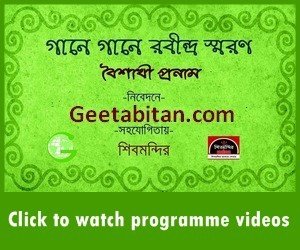Correct Pronunciation of Bengali alphabets: বাংলা বর্ণমালার নির্ভুল উচ্চারণ: Read the article⇗
The next version is coming soon.⇗
Rabindra Sangeet Albums. Sung by the verified singers of this website. 160 talented singers & over 850 songs.
Rabindra Sangeet Collections. Sung by the verified singers of this website. Nearly 500 unique Tagore songs.
Detail information about Rabindra Sangeet. All the lyrics, notations, background history with detail musical compositions, English translation and many more.
Lyric and background history of song lukiye aso adhar rate
Song of Rabindranath Tagore
This page contains lyric of Tagore song lukiye aso adhar rate and its transliteration in English with background history. Background of the song includes the place and date of the song written by Rabindranath, name of the newspaper or magazine the song was first published in and the name of the person who had prepared the notation or swaralipi. This page also contains the musical composition of song like parjaay, taal, raag and ango.
The other related elements of this song like translation in English and Hindi, notation in Bengali (swaralipi), staff notation (western) which are available in other pages, please find the related links below. We have also provided the pdf's of lyric, notation and staff notation with midi with downloadable links so that people may find it easier to get the song and notations in printed format.
Musical composition and background history of the song:
Parjaay: Puja (90)
Upa-parjaay: Bondhu
Taal: Kaharwa
Raag: Pilu
Written on: 1913 (14 Agrahayan 1320)
Place: Shantiniketan
Collection: Geetimalya
Swarabitan: 42 (Arupratan)
Notation by: Dinendranath Tagore
Notes: This song was written on 30th November, 1913 at Shantiniketan.
Three songs were written on two back to back days. They are Lukiye Aaso Aandhar Raate …, Aamar Kanttho Tnaare Daake… and Aamar Sakol Knaata Dhonyo Kore … .
On 23rd November, 1913 a crowd of five hundred people had moved from Kolkata to Shantiniketan by train in order to congratulate him after Rabindranath had received the Nobel Prize. Among the mass he had noticed a few people on the front row who were always been vocal in order to cause enough disrepute for him. (Although, no report has ever been published to reveal their identity.) His speech in reply had created a huge controversy. Kanika Bandyopadhyay in her book ‘Rabindra Sangeet’ had opined that these three songs may have been written within a week as a reaction of this ceremony. He had used the words ‘Jini prosanno hole asommaner protyek knaatati phul hoye phote’, in his speech, which can be seen to be reflected in the third song.
The day before composition of the song ‘Lukiye Aaso Aandhar Raate…’ Andrews had left Shantiniketan to join the movement at Durban with Gandhi. Enough critsism he had to face when he had, despite being white, touched the feet of Gandhi publicly. His mother was ill back in England. But he had cancelled his trip to see his ailing mother and instead moved to Durban. He did not see his mother when he reached England, she had already died. Rabindranath had sent a letter from Shantiniketan, to Andrews as a consolation, containing English translation of the song – ‘You have come to me hidden in the darkness of night, my Friend.’
Lyric in Bengali
All related links of this song
Download or print this lyric
Transliteration in English
Lukiye aaso aandhar raate, Tumii aamar bondhu, Lawo je tene kotthin haate, Tumi aamar aanondo. Dukhhorather tumii rathi, Tumii aamar bondhu. Tumi sankat tumii khoti, Tumi aamar aanondo. Shotru aamare karo go joy, Tumii aamar bondhu. Rudro tumi hey bhayer bhay, Tumi aamar aanondo. Bajro eso hey bokkho chire, Tumii aamar bondhu. Mrityu lawo hey bnadhon chhnire, Tumi aamar aanondo.
More about this song lukiye aso adhar rate
Get detail information about the song i.e. musical composition, background history, notation, translation and staff notation with downloadable options. Visit the following links.


